- Call us: 01444 237070
- Contact Us
- Stores
- Sign In / Register
-
- Back
- Used Cameras
- Used Accessories
- Used Lenses
- Used Video
- Used Film Equipment
- Used Stock Alert
- Used Blank Test
- Sell or Part Exchange
- Used Clearance
- Recently Added Used Equipment
- Park Picks
- All Used Black Friday Deals
- Faulty
- Trade-In
- Blog
- New in
- Call us
- Contact us
- Stores
- Sign in
- Categories
- Tips & Inspiration
- Reviews
- News
- Events
- Features
- Buying Guides
- Competitions
How to take great pet photos
Britain is a nation of pet lovers and with National Pet Day on April 11, 2023, we thought we’d ask our team to share tips on how to take great pet photos. Whether you have a cat, dog, or an exotic domesticated animal, many of us love to have memorable photos to cherish of our companion animals.
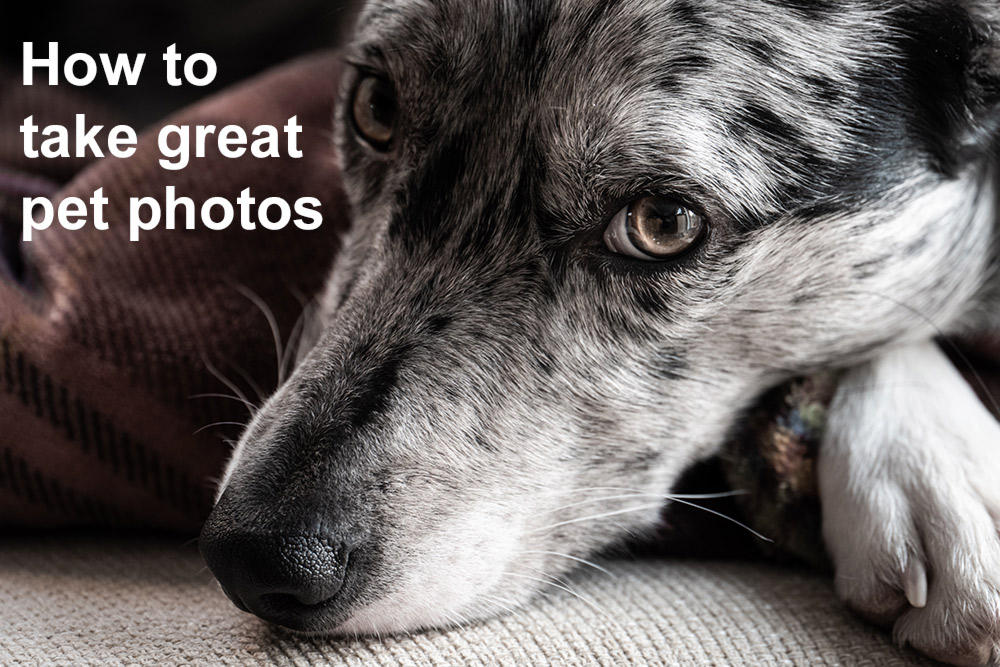
In this guide you’ll discover which is the best camera and lens to use, as well as what makes a successful pet photograph. We discuss the best camera settings to try for different types of portrait, which will help you draw out your pet’s unique character.
Whether you intend to do some dog photography or cat photography, pets aren’t the easiest subjects to photograph, but with a little patience, a few treats and the right camera accessories you’ll be taking beautiful pet photos in no time.
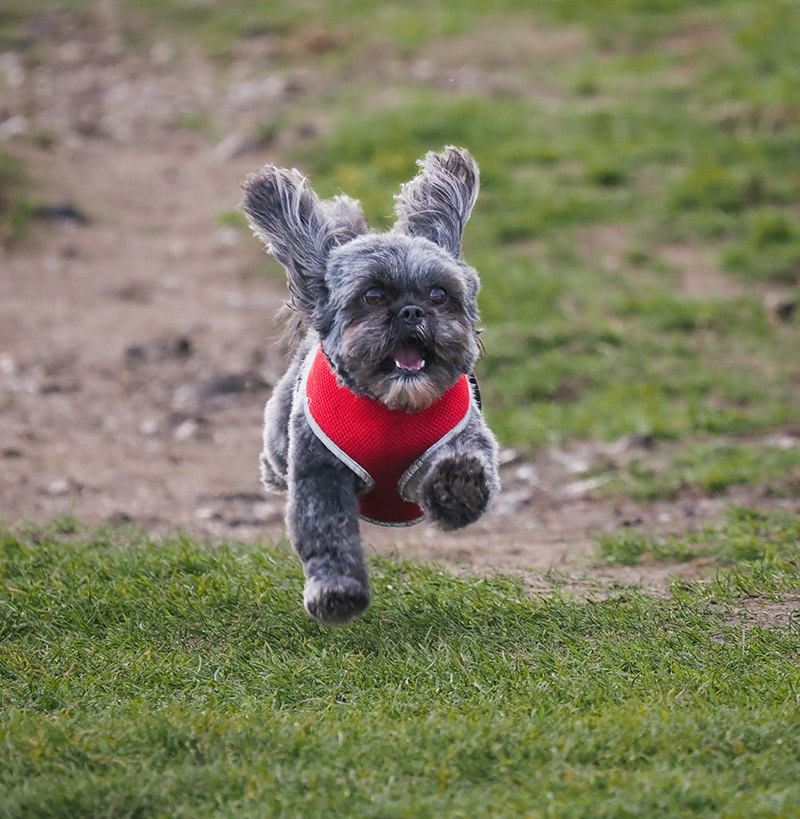
Running dog taken with Olympus OM-1 camera and Olympus M.Zuiko Digital ED 150-400mm F/4.5 TC 1.25x IS PRO Lens @ 400mm. Camera settings: 1/1000 sec. f/4.5. ISO 800. ©Gareth Evans
Animal subject detection AF
Many mirrorless cameras (and a handful of DSLRs) include animal subject detection, which enables them to recognise and keep focus on common animals, including cats, dogs and birds. Once activated, this feature will help you capture sharp photos of your pet, which is essential if you intend to print out your photos, using lab photo printing or a digital photo printer at home.
Animal AF is by no means essential and many of the photos featured in this guide have been taken without, so don’t despair if your camera doesn’t have this feature.
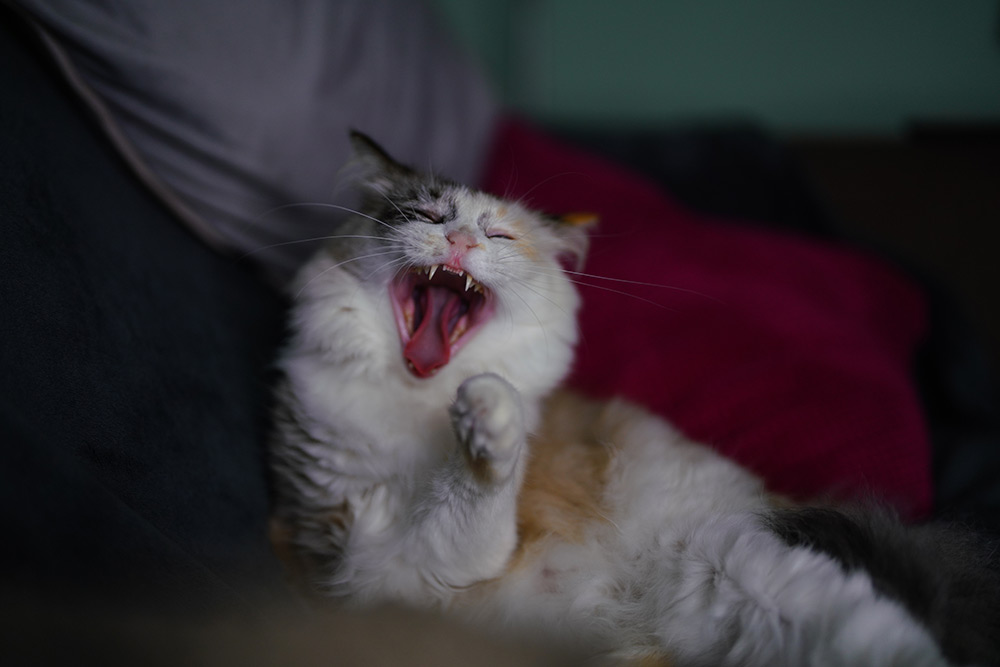
Yawning cat taken with Sony a7r III camera and Sony FE 50mm F/1.2 GM Lens. Camera settings: 1/500. f/1.2 ISO 500. ©Ian Chiles
The best camera for pet photography
Most cameras available today are capable of capturing brilliant photos, although we generally recommend an interchangeable lens camera for greater control. Specific camera features which will help with pet photography include:
- Animal detect AF
- Fast continuous burst shooting with tracking and auto exposure
- In-body stabilisation
- Strong low light performance
Other nice to have features include weather sealing for outdoor shoots, a high buffer depth to capture lots of pictures in burst mode and higher resolution in order to crop-in when you need to.
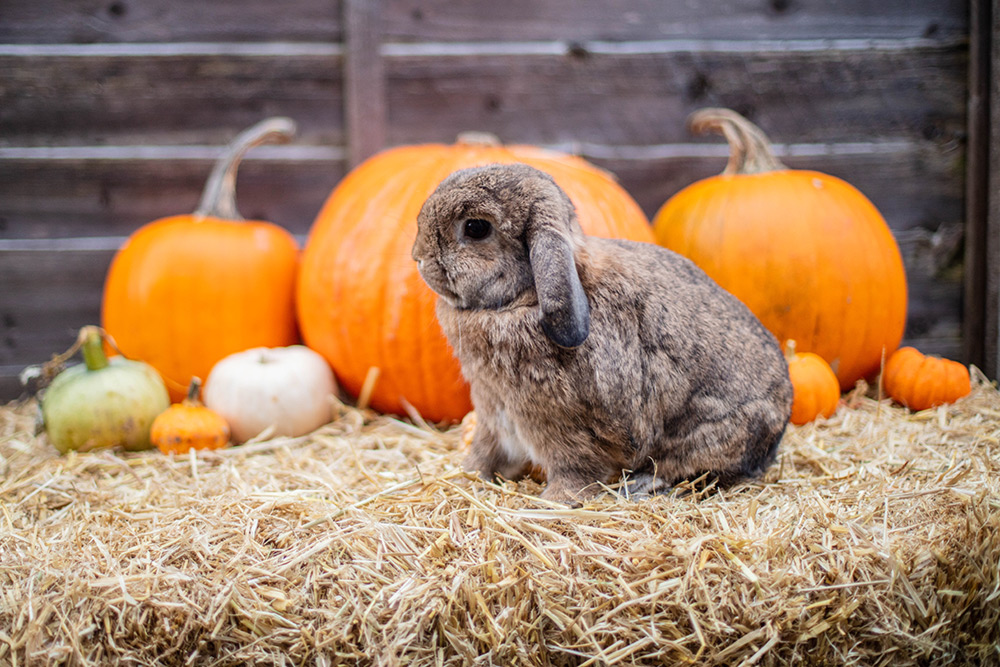
Rabbit taken with Canon EOS 5DS and Canon EF 50mm F/1.4 USM Lens. Camera settings: 1/250. f/1.4 ISO 400. ©Sarah Baker
The table below highlights the 10 best cameras for pet photography, which all include animal AF, as well as other useful features to help you get the best shots.
|
Camera |
FPS (RAW AF + AE) |
IBIS |
Notable |
Price |
|
20fps |
7-stops |
40MP, blackout-free EVF, improved AF algorithm, better battery performance |
£1,699.00 |
|
|
10fps |
8-stops |
61MP, dedicated AF processor, 693 Phase-detection AF, improved low light performance |
£3,999.00 |
|
|
20fps |
8-stops |
20.1MP, Dual Pixel CMOS II AF, huge ISO range |
£1,999.00 |
|
|
30fps |
8-stops |
32.5MP, Dual Pixel CMOS AF II, 651 autofocus zones with almost 100% coverage |
£1,349.00 |
|
|
50fps |
8-stops |
20.4MP, 1053 focus areas, first IP53 weather resistant camera body |
£1,999.00 |
|
|
20fps |
6-stops |
45.7 MP, advanced noise-reduction algorithm, 493-point AF system |
£5,299.00 |
|
|
10fps |
5-stops |
45.8MP, AF down to -6EV and dual processors for resposiveness |
£3,099.00 |
|
|
20fps |
8-stops |
45MP, Dual Pixel CMOS II, AF works down to -6EV |
£4,299.00 |
|
|
40fps |
8-stops |
24MP, AI-driven Dual Pixel CMOS AF II, high native ISO 102,400 |
£2,779.00 |
|
|
10fps |
5.5 stops |
33MP, 759 AF points covering most of the sensor, improved low light performance |
£2,399.00 |
Even if your camera doesn’t come with animal subject detection, you can still snap wonderful photos of your pet, simply by using the right camera settings and some know-how, which we highlight below.
A used camera is a worthy consideration, especially if looking for the best affordable camera for pet photography, where you’ll find extremely capable DSLR and mirrorless options at a fraction of the price of buying new.

Black Labrador taken with Sony a7r III camera and Sigma 24mm f/1.4 DG DN Art lens for Sony. Camera settings: 1/1600. f/1.4 ISO 100. ©Nick Dautlich
Which lens for pet photography?
The ability to switch focal lengths is extremely useful for pet photography, especially when your furry friend is on the move. This can be done easily with a zoom lens, or by moving yourself if you’re shooting with a prime lens. Our camera equipment guides have plenty of useful advice if you’re not sure what the difference is between a prime lens vs zoom lens, or want a general guide to camera lenses.
Other useful features to look for in a pet photography lens include:
- A wide maximum aperture to let in lots of light and separate your subject from the background (f/2.8 and wider is brilliant)
- Optical stabilisation, which allows you to handhold in low light and still achieve sharp focus at slower speeds
- Quick focus will help keep even a fast-moving subject sharp
If you’re trying cat or dog portrait photography and want to achieve frame-filling results, a telephoto zoom lens is a good lens to start with. A standard lens, wide angle zoom or prime lens is ideal in order to achieve a more intimate portrait and environmental shot, which includes the subject and their surroundings. Much like when photographing human portraits, including the surrounding setting is a great way to bring out your pets personality. For example if they enjoy running on the beach or playing in the park, you can include this in your photo with a wider lens.
Professional and enthusiast pet photographers will often bring two or three lens options for a pet session, in order to experiment and have the best chance of capturing lots of great shots. A 24mm wide angle lens was used for the black lab photo here, taken during the Sigma 24mm F/1.4 DG DN Art Lens review.
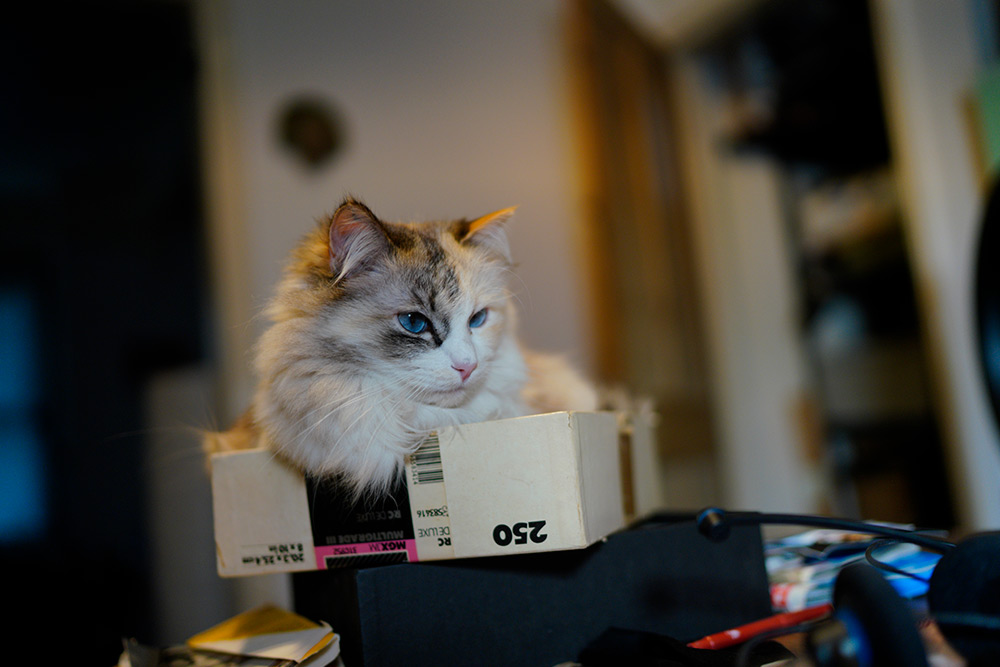
Cat taken with Sony a7r III camera and Sony FE 35mm F/1.4 ZA Zeiss Distagon T* Lens. Camera settings: 1/1250. f/1.4 ISO 640. ©Ian Chiles
Best camera settings for pet photography
It’s a good idea to have your camera settings dialled-in beforehand, so you’re ready to capture the perfect moment as it happens. It’s also worth noting that regardless of the image you have in mind, your pet will do whatever they want to, so you have to be prepared to react by switching settings according to the situation. You can learn manual photography in 10 minutes and we typically recommend shooting in Manual mode to get the greatest control when you’re familiar with your camera.
- If available, switch on animal subject recognition, choosing a cat, dog or other appropriate animal if your camera offers it
- Choose AF-C (continuous autofocus) mode to track a moving subject
- Make sure both camera body and lens stabilisation are switched on, selecting panning mode if you intend to pan as your pet runs around
- Select a fast shutter speed of 1/1000 second or even slightly faster, in order to freeze the action if your pet is running or moving erratically
- For slower movements 1/250 second should be quick enough
- Set a wide to middle lens aperture, which gives a shallow depth of field and blurs the background, while keeping the animal in focus
- Shoot at the lowest ISO possible for the shutter speed selected. The closer to base ISO you can get, the better, although for low light you might need to increase ISO
- If your pet is sleeping or remains stationary, you can shoot at lower speeds, with a lower ISO and still achieve sharp focus
It’s a good idea to experiment with different settings and see which yields the best results. You’ll also need to adjust settings according to what the animal is doing at the time, for example photographing a skateboarding dog will require different settings to capturing a sleeping cat.

Running dog taken with Canon EOS 5DS and Canon EF 50mm F/1.4 USM Lens. Camera settings: 1/1250. f/2.8 ISO 400. ©Sarah Baker
How to get more professional looking pet photos
Whether you want to be the next Dogist, or simply take lovely photos to share with family and friends, a few useful tips go a long way when photographing animals. The following creative tools will complement any camera settings, and help you capture more professional pictures of your pooch:
- Shoot at your pet’s eye level if possible. Crouch, lie down or get them to jump!
- Always aim to get the prominent eye in the frame sharp, if possible
- Separate your subject from distracting busy backgrounds, by either changing compositions, moving away from the background or by using a wider aperture
- Using natural light is preferable to many pet photographers although you can add soft supplemental photography lighting if it enhances the final image. A reflector is a brilliant way to bounce light and reduce shadows, but you may need an assistant to hold lights and reflectors
- Try and capture your pet’s distinctive personality by putting them at ease and photographing them in their favourite settings
- You can put your animal at ease with their favourite toy, a squeaky ball or tempt them with the occasional treat
- Experiment with lots of different compositions, trying some close-ups and other shots from further away in order to find the best framing
- Practice, practice and more practice makes the perfect shot!
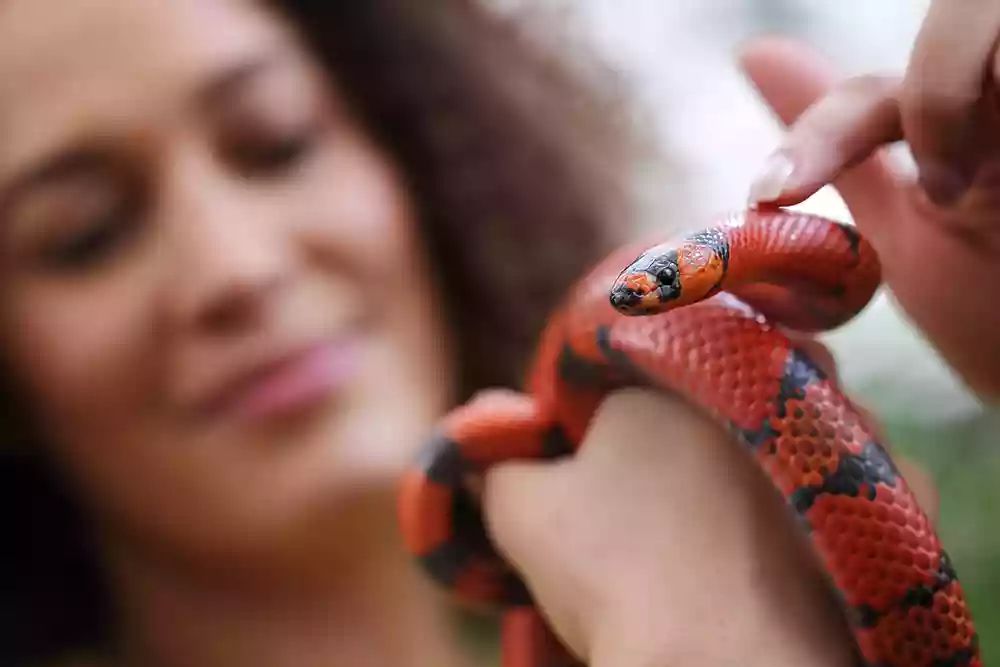
Snake taken with Canon EOS R5 and Canon RF 100mm F2.8 L Macro IS USM Lens. Camera settings: 1/320. f/3.5 ISO 1600. ©Canon
What makes a successful pet photograph?
There’s no right or wrong photo and if you’re happy with the outcome that’s a success. It’s also worth noting that the most popular pet photographs typically combine appropriate technical settings with composition and light, which ideally all converge to bring out the animal’s personality.
For example, it’s absolutely fine to have some motion blur in the image if it enhances the naturally fast-moving nature of your dog. Similarly, using bokeh and soft blurry backgrounds while your cat sleeps can create a lovely result.
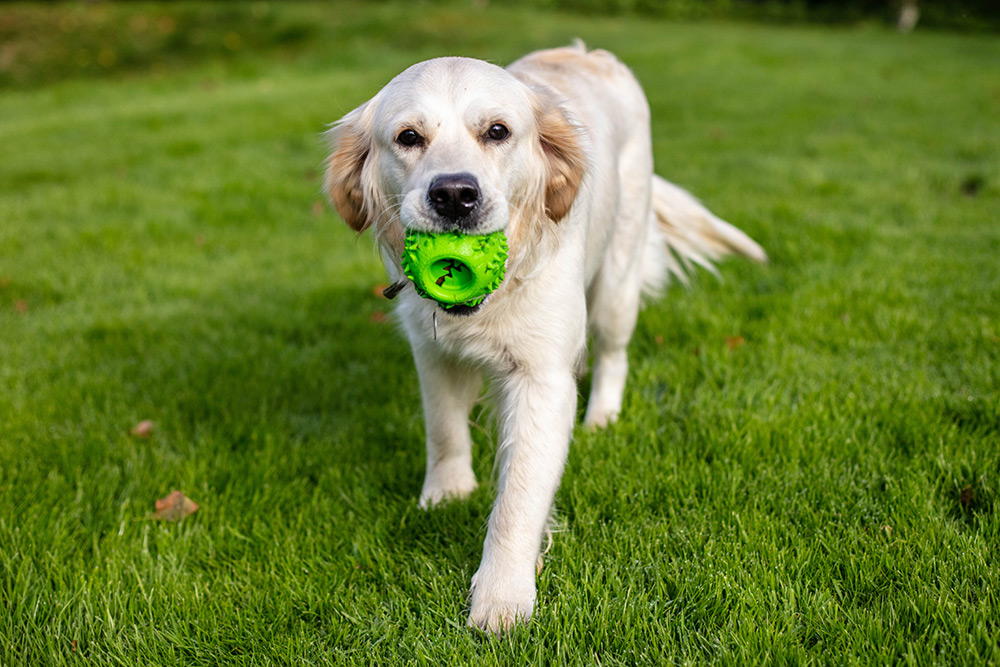
White Labrador and toy taken with Canon EOS 5DS and Canon EF 50mm F/1.4 USM Lens. Camera settings: 1/3200. f/2.8 ISO 500. ©Sarah Baker
The most successful pet photos will also have distinctive lighting, which accentuates the subject and enhances the mood. That could be anything from super-real bright sunlight enhanced by a flashgun to add pop, or it could be soft natural light entering through a window on an overcast day, as they lay on the bed. Once again it’s well worth stressing that experimenting with different equipment, techniques and available light will help you capture your favourite pet shots.
Watch How to Photograph your Pet | Tutorial Tuesday here
Gareth Evans has some fabulous photos and tips to guide you further on your quest to capture brilliant pet photos.
Capturing beautiful and memorable pets photography takes patience, experimentation with camera settings and the ability to move around and try out compositions. Animal AF helps enormously but it isn’t essential and you can achieve wonderful images by shooting with a wider aperture and low ISO, whilst trying to include your companion animal’s personality.
Browse our huge range of cameras and lenses from every major brand to find the perfect system for you to take the best pet photos ever!
Share this post:
By Nick Dautlich on 10/03/2023
Nick Dautlich
Senior Content Writer and Product Reviewer
Nick Dautlich is the Senior Content Writer and Product Reviewer at Park Cameras, with over 15 years of photography experience. A Sony Imaging Professional and expert reviewer, Nick has worked with major brands such as Canon, Sony and Nikon. His work is also featured on Vanguard World UK’s website, Capture Landscapes, and Shutter Evolve. Nick’s photography includes National Trust projects and magazine covers and he is passionate about landscapes and storytelling. Nick also enjoys hiking and teaching his children about nature. Learn more on his profile page.

Trade in your old equipment
Fast and easy trade in service ensures your old gear is collected efficiently and you are paid quickly! It's very simple to trade in your unwanted photography gear. Just head over to our dedicated Sell or Part Exchange page, fill out the details, and we'll get back to you with an offer for your old gear. Take the cash, or put it towards the cost of your new gear. It's up to you! Find out more
sign up to the newsletter
Keep up to date on the latest photography news, events and offers. Sign up now
